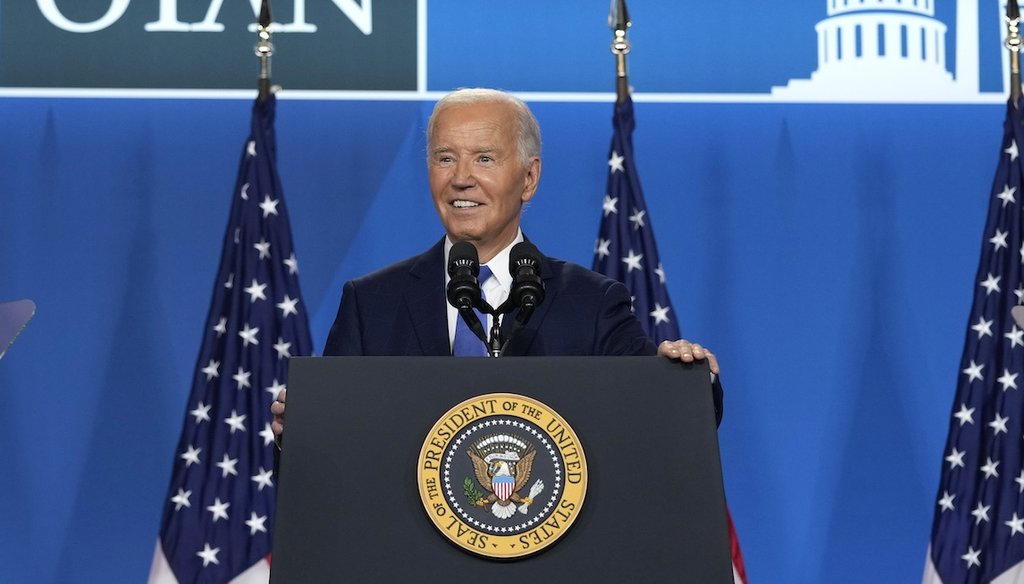Stand up for the facts!
Our only agenda is to publish the truth so you can be an informed participant in democracy.
We need your help.
I would like to contribute

President Joe Biden speaks July 11, 2024, at a news conference following the NATO Summit in Washington. (AP)
President Joe Biden defended his ability to serve as president and the Democratic nominee against former President Donald Trump during a July 11 press conference following the NATO summit in Washington, D.C.
The press conference — his first in eight months — came amid calls from some congressional Democrats and donors for Biden to drop out of the presidential race after his June 27 debate performance. Biden said he wouldn’t drop out unless his team showed him there was no path for him to win.
"No one’s saying that. No poll says that," Biden said in a whisper.
Here are the facts on seven of the president’s comments.
Says Donald Trump "already told Putin and I quote, ‘Do whatever the hell you want.’ In fact, the day after Putin invaded Ukraine, here's what he said, ‘It was genius. It was wonderful.’"
Biden left out context and was off about when Trump paid Putin the compliment.
Trump, at a Feb. 10 campaign rally in South Carolina, recalled a conversation with an unnamed leader of a NATO member state who he said asked whether the U.S. would protect the leader’s country if it were attacked by Russia, even if it hadn’t met defense spending targets. Trump said he told the leader, "No, I would not protect you. In fact, I would encourage them to do whatever the hell they want. You gotta pay. You gotta pay your bills."
Trump did praise Russian President Vladimir Putin two days before he invaded Ukraine, not the day after, as Biden said.
Russia invaded Ukraine on Feb. 24, 2022.
On a Feb. 22, 2022, radio show, Trump was complimentary of Putin’s decision to declare breakaway regions of Ukraine as independent.
"I went in yesterday and there was a television screen, and I said, ‘This is genius.’ Putin declares a big portion of the Ukraine — of Ukraine. Putin declares it as independent," Trump said, adding, "Oh, that’s wonderful," sarcastically.
"So, Putin is now saying, ‘It’s independent,’ a large section of Ukraine. I said, ‘How smart is that?’ And he’s gonna go in and be a peacekeeper. That’s strongest peace force. … We could use that on our southern border," Trump said. "That’s the strongest peace force I’ve ever seen. There were more army tanks than I’ve ever seen. They’re gonna keep peace all right. No, but think of it. Here’s a guy who’s very savvy … I know him very well. Very, very well."
"Trump’s calling for a 10% tariff on everything Americans buy, including foods from overseas, vegetables, and other necessities. And economists tell us that that would cost the average American working family another $2,500 a year. It's a tax of $2,500 a year."
Economists say Trump’s proposed 10% tariff on all imported foreign products (not "everything Americans buy") will cost consumers more money, but Biden’s $2,500 figure is higher than recent estimates.
How much the tariff will cost consumers is debatable. The American Action Forum, a center-right think tank, estimated June 25 that households would pay from $1,700 to $2,350 more annually. The Peterson Institute of International Economics, another think tank focused on global economic matters, estimated in May that a middle-income household would pay about $1,700 more per year.
The Center for American Progress, a left-leaning policy research organization, in March estimated cost to consumers at $1,500.
"I took executive action last month. As a consequence, working with Mexico, border encounters have gone down over 50%. The current level is lower today than when Trump left office."
This comparison is misleading. The Department of Homeland Security on June 25 said that illegal immigration encounters at the southern border dropped 40%, to fewer than 2,400 each day, after a June 4 policy largely barred asylum access for people entering the U.S. at the southern border. Since the policy was announced only a few weeks ago, it’s unclear whether the drop in illegal immigration will continue.
In December 2020 and January 2021 — when Trump was still in office — Border Patrol encountered immigrants illegally crossing the U.S.-Mexico border about 71,000 and 75,000 times, respectively. That’s a daily average of around 2,300 to 2,400 encounters. (Biden was inaugurated Jan. 20, 2021.)
The latest publicly available data for Biden’s presidency shows 170,000 southwest border encounters in May. That contradicts Biden’s claim that "the current level" is lower than when Trump left the presidency.
CBS and The New York Times reported that unreleased data shows border encounters dropped to about 83,000 in June. That’s about 50% lower than the public May figures, but still higher than the last months of Trump’s presidency.
"The UAW just endorsed me."
This needs context. Biden gave the impression this endorsement recently happened. But it came in January, when United Auto Workers President Shawn Fain announced the union’s endorsement of Biden, saying, "Instead of talking trash about our union, Joe Biden stood with us."
That endorsement came before Biden’s debate performance sparked concerns about his candidacy, age and fitness for office. We contacted the UAW about the status of its endorsement but received no reply.
"At least five presidents running or incumbent presidents … had lower numbers than I have now later in the campaign."
Biden didn’t specify if he was referring to campaign polling data or job approval ratings. The claim is true when looking at polling data, but wrong for approval ratings.
The Biden campaign pointed us to polling data that shows six presidents (either running for the first time or as an incumbent) who fared worse in national polls at a comparable point in their campaigns and won.
Biden, according to FiveThirtyEight’s national average of polls, trails Trump by 1.9 percentage points as of July 12.
Six other current or future presidents were trailing their opponents by greater numbers later in their campaigns, according to polling data:
-
Trump trailed Hillary Clinton by seven points in a Real Clear Politics national poll average in October 2016. He defeated Clinton in November.
-
Barack Obama trailed John McCain by 2.9 points in September 2008 and trailed Mitt Romney by 1 point in October 2012, according to Real Clear Politics data. He won both races.
-
George W. Bush trailed John Kerry by 2.5 points in August 2004, according to Real Clear Politics data, but won reelection.
-
Bill Clinton trailed George H.W. Bush by 8 percentage points in 1992 according to Gallup polling data, but won in November.
-
George H.W. Bush trailed Michael Dukakis by 17 points in July 1988, according to Gallup polling data, but won in November.
-
John F. Kennedy trailed Richard Nixon by 6 points in Gallup polling in August 1960 before winning in November.
Approval ratings for Biden aren’t as promising. His approval rating when he made the claim was 36.8% (and inched up to 37.3% the day after his news conference), according to data from FiveThirtyEight.
The FiveThirtyEight data goes back to the Harry Truman administration from 1945 to 1953. Only Jimmy Carter (33.9%) and George H.W. Bush (36.7%) had lower approval ratings through the same time as Biden. Carter’s approval rating dipped as low as 32.2% later in his 1980 campaign. George H.W. Bush fell as low as 30.1% late in his 1992 campaign.
Both incumbent presidents lost their reelection bids.
In the U.S. "more children are killed with, by a bullet than any other cause of death."
This is accurate. The Centers for Disease Control and Prevention data shows that in 2022, the most recent year of non-provisional data, firearms were the leading cause of death for children ages 1 to 17. (Researchers generally say they don’t include infants in their analyses because of certain conditions unique to babies.)
In total, 16,318 children ages 1 to 17 died in 2022. Of those deaths, firearms were the No. 1 cause, causing 2,526 deaths. Motor vehicle traffic crashes, broadly, were the second leading cause of death, causing 2,240 deaths.
Firearms are not the leading cause of death for each age in that group. Firearm deaths are far more common among older children, according to the CDC data and researchers.
Trump "says he’s gonna do away with the civil service, eliminate the Department of Education."
This is largely accurate. In one of his agenda policy videos, Trump promised to close the Department of Education and "to send all education work and needs back to the states." However, congressional approval is required, so Trump couldn’t do it on his own.
Trump has promised to "re-issue my 2020 Executive Order restoring the President's authority to remove rogue bureaucrats." More commonly known as Schedule F, this order would reclassify certain federal employees, stripping away protections from being fired or political pressures.
Of the nearly 2 million federal employees, the vast majority are nonpolitical career officials who carry out their duties regardless of the administration. Currently, these employees cannot be fired for political reasons.
Trump opening up the ability to fire civil servants without cause doesn’t necessarily "do away" with the service, as Biden said, but it does put many of these jobs in jeopardy.
RELATED: Fact-checking Donald Trump on immigration, economy in first postdebate rally in Doral, Florida
Our Sources
Please see sources linked in story.





























